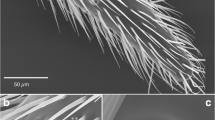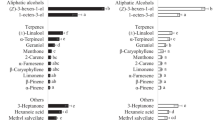Abstract
The external morphology and peripheral olfactory responses of antennal chemoreceptors of Trichogramma chilonis Ishii (Hymenoptera:Trichogrammatidae) to host related stimuli were examined by SEM and EAG technique respectively. The antennae of male and female T. chilonis reveal strong sexual dimorphism in structure as well as in types, density and distribution of individual sensillar types. The female antennae are characterized by the presence of a single uniporous sensilla on the apical tip of the dome and numerous multiporous pitted sensilla. Sensilla common to both males and females include the multiporous plate sensilla, the peg sensilla and trichoid sensilla. Differences between males and females occur with respect to their EAG profiles to 22 chemicals commonly found in plants viz., hexanal, β-pinene, citronellal, terpinene, citronellol, phytol, caryophyllene, R-(+)-limonene, linalool, carvacrol, cis-3-hexen-1-ol, ethanol, α-pinene, trans-2-hexanal, α-phellandrene, amyl acetate, cineole, quinolene, S-(−)limonene, β-myrcene, carvone, terpineol; hexane leaf extracts of three host plants of Helicoverpa armigera (cotton, chickpea and pigeon pea) and hexane scale extracts of adult males and females of H. armigera. Individually, the largest peak amplitudes in females were obtained with citronellal, phytol, caryophyllene, R-(+)-limonene, linalool, carvacrol and citronellol while in males citronellol, caryophyllene, linalool, R-(+)-limonene and amyl acetate caused the highest response. Among the different chemical classes, the largest peak amplitudes in females were obtained with oxygenated monoterpenes, while in males, fatty acid derivatives caused the highest response. In both males and females, the hydrocarbon monoterpenes caused the least response. Thus, the wide spectrum response of Trichogramma chilonis, to a wide group of chemicals belonging to different chemical classes, though varying, nevertheless suggests that using plant information enhances its parasitization efficiency.
Similar content being viewed by others
References
H. Altner (1977) Insect sensillum specificity and structure : an approach to a new typology J. Magnen P. MacLeod (Eds) Olfaction and Taste VI (Paris). Information Retrieval London 295–303
W. Amornsak B. Cribb G. Gordh (1998) ArticleTitleExternal morphology of antennal sensilla of Trichogramma australicum Girault (Hymenoptera:Trichogrammatidae) Int. J. Insect Morphol. Embryol 27 67–82
T.N. Ananthakrishnan R. Senrayan S. Murugesan R.S. Annadurai (1991) ArticleTitleKairomones of Heliothis armigera and Corcyra cephalonica and their influence on the parasitic potential of Trichogramma chilonis (Trichogrammatidae: Hymenoptera) J. Biosci 16 IssueID5 111–119
D. Bar D. Gerling Y. Rossler (1979) ArticleTitleBionomics of the principal natural enemies attacking Heliothis armigera in cotton fields in Israel. Environ. Entomol 8 468–474
Bhatnagar V.S., Lateef S.S., Sithanantham S., Pawar C.S., Reed W.(1982). Research on Heliothis at ICRISAT. International Workshop on Heliothismanagement. 15–20 November, ’81. ICRISAT Centre, Patancheru, AP, India. pp. 385–396.
K.S. Boo J.P. Yang (2000) ArticleTitleKairomones used by Trichogramma chilonis to find Helicoverpa assulta eggs J. Chem. Ecol 26 359–375
T. Cabello P. Vargas (1985) ArticleTitleEstudio con olfactometro de la influencia de la planta y del insecto huesped en la actividad de busqueda de Trichogramma cordubensis Vargas y Cabello y de T.sp. p. buesi (Hym., Trichogrammatidae) Bol. Serv. Plagas 11 237–241
C.M. Moraes Particlede W.J. Lewis P.W. Pare H.T. Alborn J.H. Tumlinson (1998) ArticleTitleHerbivore infested plants selectively attract parasitoids Nature 393 570–573
V.G. Dethier (1972) ArticleTitleSensitivity of the contact chemoreceptors of the blowfly to vapours Proc. Nat. Acad. Sci. USA 69 2189–2192
M. Dicke R. Gols D. Ludeking M.A. Posthumus (1999) ArticleTitleJasmonic acid and herbivory differentially induce carnivore attracting plant volatiles in lima bean plants J.Chem. Ecol. 25 1907–1922
J.C. Dickens (1984) ArticleTitleOlfaction in the boll weevil, Anthonomus grandis, Boh (Coleoptera; Curculionidae)Electroantennogram studies. J. Chem. Ecol. 10 1759–1785
Gautam R.D.(1994). Techniques of mass rearing of laboratory hosts. In: Biological Pest Suppression, Westvill Publ. House, New Delhi. pp. 76–105.
R. Gols M.A. Posthumus M. Dicke (1999) ArticleTitleJasmonic acid induces the production of gerbera volatiles that attract the biological control agent Phytoseilus persimilis Entomol. Exp. Appl 93 77–86
M.E.F. Hoballah T.C.J. Turlings (1999) ArticleTitleExperimental evidence that plants under caterpillar attack may benefit from attracting parasitoids Evol. Ecol. Res. 3 553–565
M Hilker C. Kobs K. Schrank M. Varama (2002) ArticleTitleInsect egg deposition induces Pinus to call for egg parasitoids J. Exp. Biol. 205 455–461
N. Isidoro F. Bin S. Colazza S.B. Vinson (1996) ArticleTitleMorphology of antennal gustatory sensilla and glands in some parasitoid Hymenoptera with hypothesis on their role in sex and host recognition J. Hymenop. Res 5 206–239
N.F. Isidoro R. Romani F. Bin (2001) ArticleTitleAntennal multiporous sensilla: their gustatory features for host recognition in female parasitic wasps (Insecta, Hymenoptera, Platygastroidea) Microsc. Res. Tech. 55 IssueID5 350–358
R.L. Jones W.J. Lewis M. Beroza B.A. Bierl A.N. Sparks (1973) ArticleTitleHost seeking stimulants (kairomones) for the egg parasite Trichogramma evanescens Environ. Entomol 2 593–596
L. Kaiser M.H. Pham-Deluge E. Bakchine C. Masson (1989) ArticleTitleOlfactory responses of Trichogramma maidisPint Et. Voeg.: effects of chemical cues and behavioral plasticity. J. Insect Behav. 2 701–712
M.A. Keller W.J. Lewis R.E Stinner (1985) ArticleTitleBiological and practical significance of movement by Trichogramma species A review. Southwest Entomol. Suppl 8 138–155
C. Leconte J. Pouzat (1985) ArticleTitleResponses electroantennographiques dedeux parasitoids Ichneumonides, Diadromus pulchellus et D. collaris, aux odeurs de vegetaux, du phytophagehote Acrolepiopsis assectella et du partenaire sexuel Entomol. Exp. Appl 39 295–306
W.J. Lewis D.A. Nordlund R.C. Gueldner P.E.A. Teal J.H. Tumlinson (1982) ArticleTitleKairomones and their use for management of entomophagous insects XIII. Kairomonal activity for Trichogramma spp. of abdominal tips, excretion and a synthetic sex pheromone blend of Heliothis zea (Boddie) moths. J. Chem. Ecol. 8 1323–1331
W.J. Lewis J.H. Tumlinson S. Krasnoff (1991) ArticleTitleChemically mediated associative learning: an important function in the foraging behavior of Microplitis croceipes(Cresson) J. Chem. Ecol. 17 1309–1325
W.J. Lewis R.L. Jones A.N. Sparks (1972) ArticleTitleA host seeking stimulant for the egg parasite, Trichogramma evanescensIts source and demonstration of its laboratory and field activity. Ann. Entomol. Soc. Amer 65 1087–1089
Y. Li J.C. Dickens W.W.M. Steiner (1992) ArticleTitleAntennal olfactory responsiveness of Microplitis croceipes (Hymenoptera: Braconidae) to cotton plant volatiles J. Chem. Ecol. 18 1761–1773
J.H. Loughrin A. Manukian R.R. Heath T.C.J. Turlings J.H. Tumlinson (1994) ArticleTitleDiurnal cycle of emission of induced volatile terpenoids by herbivore-injured cotton plants. Proc Natl. Acad. Sci. USA 91 11836–11840
T.M. Manjunath V.S. Bhatnagar C.S. Pawar S. Sithanantham (1989) Economicimportance of Heliothis spp. in India and an assessment of their natural enemies and host plants E.G. King R.D. Jackson (Eds) Proceedings of the Workshop on Biological Control of Heliothis: Increasing the Effectiveness of Natural Enemies Far Eastern Regional Research Office USDA New Delhi 197–228
L. Mattiaci M. Dicke M.A. Posthumus (1994) ArticleTitleInduction of parasitoid attracting synomone in Brussels sprouts plant by feeding of Pieris brassicae larva: role of mechanical damage and herbivore elicitor J.Chem. Ecol. 20 2229–2247
H.J. McAuslane S.B. Vinson H.J. Williams (1990) ArticleTitleInfluence of host plant on mate location by parasitoid Campoletis sonorensis (Hymenoptera:Ichneumonidae) Environ. Entomol 19 26–31
T. Meiners M. Hilker (1997) ArticleTitleHost location in Oomyzus gallerucae (Hymenoptera: Eulophidae), an egg parasitoid of the elm leaf beetle, Xanthogaleruca luteola (Coleoptera: Chrysomelidae) Oecologia 112 87–93
T. Meiners M. Hilker (2000) ArticleTitleInduction of plant synomones by oviposition of a phytophagous insect J. Chem. Eol 26 221–232
H. Nadel J.J.M. Alphen Particlevan (1987) ArticleTitleThe role of host and host plant odors in the attraction of a parasitoid, Epidinocarsis lopezi, to the habitat of its host, the cassava mealy bug, Phenacoccus manihoti Ent.Exp. Appl. 45 181–186
L.P.J.J. Noldus (1988) ArticleTitleResponse of the egg parasitoid Trichogramma pretiosum to the sex pheromone of its host Heliothis zea. Entomol Exp. Appl 48 293–300
L.P.J.J. Noldus J.C. Lenteren Particlevan (1985) ArticleTitleKairomones for the egg parasite Trichogramma evanescens Westwood. II. Effect of contact chemicals produced by two of its hosts, Pieris brassicaeLand Pieris rapaeL. J. Chem. Ecol. 11 793–800
L.P.J.J. Noldus J.C. Lenteren Particlevan W.J. Lewis (1991) ArticleTitleHow Trichogrammaparasitoids use sex pheromones as kairomones : orientation behavior in a wind tunnel Physiol. Entomol. 16 313–327
D.A. Nordlund R.B. Chalfant W.J. Lewis (1985) ArticleTitleResponse of Trichogramma pretiosum females to volatile synomones from tomato plants. J. Entomol Sci. 20 372–376
D.M. Olson D.A. Andow (1993) ArticleTitleAntennal sensilla of female Trichogramma nubilale (Ertle and Davis) (Hymenoptera:Trichogrammatidae) and comparisons with other parasitic Hymenoptera Int. J. Insect Morphol. Embryol 22 507–520
R Ramachandran D.M. Norris (1991) ArticleTitleVolatiles mediating plant–herbivore–natural enemy interactions: Electroantennogram responses of Soybean looper, Pseudoplusia includens, and a parasitoid, Microplitis demolitor, to green leaf volatiles J. Chem. Ecol. 17 1665–1690
R. Ramachandran Z.R. Khan P. Caballero B.O. Juliano (1990) ArticleTitleOlfactory sensitivity of two sympatric species of rice leaf-folders (Lepidoptera:Pyralidae) to plant volatiles J. Chem. Ecol. 16 2647–2666
J. Romeis T.G. Shanower (1996) ArticleTitleArthropod natural enemies of Helicoverpa armigera (Hubner) (Lepidoptera:Noctuidae) in India Biocon. Sci. Technol 6 481–508
T. Romeis T.G. Shanower C.P.W. Zebitz (1997) ArticleTitleVolatile plant infochemicals mediate plant preference of Trichogramma chilonis. J. Chem. Ecol. 23 2455–2465
U.S.R. Röse W.J. Lewis J.H. Tumlinson (1998) ArticleTitleSpecificity of systemically released cotton volatiles as attractants for specialist and generalist parasitic wasps J.Chem. Ecol. 24 303–319
D. Schneider (1962) ArticleTitleElectrophysiological investigations on the olfactory specificity of sexual attracting substances in different species of moth J. Insect Physiol. 8 15–30
S.M. Smith (1996) ArticleTitleBiological control with Trichogramma: advances, success and potential of their use Annu. Rev. Ent 41 375–406
E. Stadler F.E. Hanson (1975) ArticleTitleOlfactory capabilities of the “gustatory” chemoreceptors of the tobacco hornworm larvae J. Comp. Physiol 104 97–102
R.A. Steinbrecht (1987) Functional morphology of pheromone sensitive sensilla G.D. Prestwich G.J. Blomquist (Eds) Pheromone Biochemistry. Academic Press New York 353–383
J.H. Tumlinson T.C.J. Turlings W.J. Lewis (1993) ArticleTitleSemiochemically mediated foraging behavior in beneficial parasitic insects Arch. Insect Biochem. Physiol 22 385–391
T.C.J. Turlings J.H. Tumlinson (1992) ArticleTitleSystemic release of chemical signals by herbivore injured corn Proc. Natl. Acad. Sci. USA 89 8399–8402
T.C.J. Turlings J.H. Tumlinson W.J. Lewis (1990) ArticleTitleExploitation of herbivore-induced plant odors by host-seeking parasitic wasps Science 250 1251–1253
T.C.J. Turlings J.H. Loughrin P.J. McCall U.S.R. Röse W.J. Lewis J.H. Tumlinson (1995) ArticleTitleHow caterpillar damaged plants protect themselves by attracting parasitic wasps Proc. Natl. Acad. Sci. USA 92 4169–4174
T.C.J. Turlings M. Bernasconi R. Bertossa F. Bigler G. Caloz S. Dorn (1998) ArticleTitleThe induction of volatile emissions in maize by three herbivore species with different feeding habits : possible consequences for their natural enemies Biol. Contr 11 122–129
T.C.J. Turlings H.T. Alborn J.H. Loughrin J.H. Tumlinson (2000) ArticleTitleVolicitin, an elicitor of maize volatiles in oral secretion of Spodoptera exigua:Isolation and bioactivity J. Chem. Ecol. 26 IssueID1 189–202
S. Udayagiri R.L. Jones (1992) ArticleTitleFlight behavior of Macrocentrus grandii Goidanich (Hymenoptera, Braconidae), a specialist parasitoid of European corn borer (Lepidoptera, Pyralidae) – factors influencing response to corn volatiles Environ. Entomol 21 1448–1456
J.N.C. Pers Particlevan der (1981) ArticleTitleComparison of electroantennogram response spectra to plant volatiles in seven species of Yponomeuta, in the Tortricid Adoxophyes orana Ent. Exp. Appl 30 181–192
L.E.M. Vet A.W. Groenewold (1990) ArticleTitleSemiochemicals and learning in parasitoids J.Chem. Ecol. 16 3119–3135
J.H. Visser (1979) ArticleTitleElectroantennogram responses of the Colorado potato beetle, Leptinotarsa decemlineata to plant volatiles Ent. Exp. Appl 25 86–97
J.H. Visser (1986) ArticleTitleHost odor perception in phytophagous insects Annu. Rev. Entomol. 31 121–144
J. Voegelé J. Cals-Usciatic J.P. Pihan J. Daumal (1975) ArticleTitleStructure de l’antennae female des Trichogrammes Entomophaga 20 161–169
D.W. Whitman (1988) Allelochemical interactions among plants, herbivores and their predators P. Barbosa D.K. Letourneau (Eds) Novel Aspects of Insect-Plant Interactions. Wiley New York 11–64
E. Zaborski P.E.A. Teal J.E. Laing (1987) ArticleTitleKairomone-mediated host finding by Spruce budworm egg parasite, Trichogramma minutum J. Chem. Ecol. 13 113–122
R.Y. Zacharuk (1980) ArticleTitleUltrastructure and function of insect chemosensilla Annu. Rev. Ent. 25 27–47
R.Y. Zacharuk (1985) Antennae, sensilla G.A. Kerkut L.J. Gilbert (Eds) Comprehensive Insect Physiology,Biochemistry and Pharmacology Nervous System: Sensory Pergamon Press Oxford 1–69
Author information
Authors and Affiliations
Corresponding author
Rights and permissions
About this article
Cite this article
Sen, A., Raina, R., Joseph, M. et al. Response of Trichogramma chilonis to infochemicals: an SEM and electrophysiological investigation. Biocontrol 50, 429–447 (2005). https://doi.org/10.1007/s10526-004-1295-1
Received:
Revised:
Issue Date:
DOI: https://doi.org/10.1007/s10526-004-1295-1




